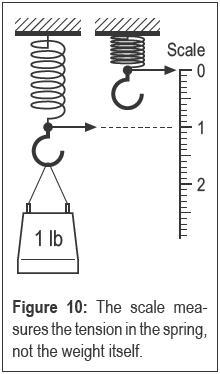The Measurement Mechanism
Let’s look at our perception problem from a more mechanical angle. Our senses are instruments that measure everything they perceive. When we hear a sound, we determine if it’s loud or soft; when we see an object, we can (usually) tell which color it is; and when we touch something, we immediately know if it’s warm or cool, wet or dry.
All measurement tools operate similarly. Think of a scale with a one-pound weight on it. The traditional weighing mechanism is made of a spring that stretches according to the weight, and a ruler that measures the tightness of the spring. Once the spring stops stretching and rests at a certain point, the numbers on the ruler indicate the weight. Actually, we are not measuring the weight, but the balance between the spring and the weight (Figure 10).
This is why Baal HaSulam says that we cannot perceive the Abstract Form, the object in and of itself, because we have absolutely no connection with it. If we can place the object on a spring and measure how it stretches the spring, we’ll get a result. But if we can’t measure what is happening on the outside, if we have no perception of the external object, it’s as though there is no object at all. Moreover, if we use a defective spring to measure an external object, we will get the wrong result. This is what happens when we grow older and our senses begin to deteriorate.
In spiritual terms, the outside world presents Abstract Forms to us, such as the weight. Using the spring and the dial—the will to receive and the intention to bestow—we measure how much of the Abstract Form we can receive. If we could build a gauge that would “measure” the Creator, we could sense Him just as we sense this world.
In fact, there is such a gauge—it is known as “the sixth sense.”

